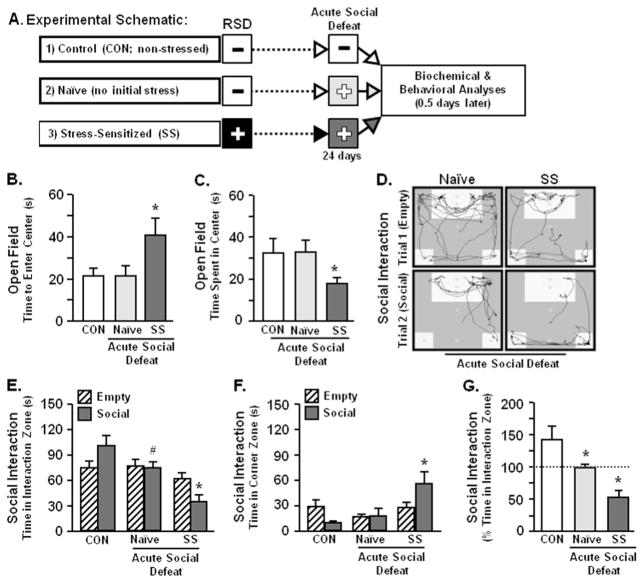Figure 3.
Acute social defeat re-established anxiety-like behavior and exaggerated social avoidance in SS mice. These studies included three experimental groups of mice: 1) CON (nonstressed) mice that were not exposed to any social defeat; 2) naïve (no initial stress) mice subjected to acute social defeat 24 days later; and 3) SS mice that were exposed to repeated social defeat (RSD) and subjected to acute social defeat 24 days later. Anxiety-like behavior and social avoidance were determined 0.5 days after acute social defeat. (A) Experimental schematic is shown. Acute social defeat caused anxiety-like behavior in SS mice with (B) increased time to enter the center of the open-field (F2,32 = 3.41, p < .05) and (C) decreased total time spent in the open-field (F2,32 = 2.77, p = .07). (D) Representative activity traces of naïve and stress-sensitized mice are shown for empty and social trials. Acute social defeat in naïve mice promoted social avoidance but exacerbated social withdrawal in SS mice with (E) decreased time spent in the interaction zone (F2,24 = 11.34, p < .003) and (F) increased time spent in corner zones of social avoidance test following acute social defeat (F2,24 = 4.56, p < .05). (G) Percent time spent in the interaction zone [100 × (social/empty)] was markedly reduced in stress-sensitized mice compared with control mice (F2,24 = 6.51, p < .02). Bars represent the mean ± SEM. Means with asterisk (*) are significantly different from CON (p < .05) and means with (#) tended to be different from CON (p < .06–.10).

